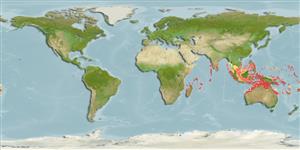分類 / Names
共通名の | 類義語 | Catalog of Fishes(部類, 種) | ITIS | CoL | WoRMS | Cloffa
Environment: milieu / climate zone / depth range / distribution range
生態学
海 関連する礁; 深さの範囲 1 - 96 m (Ref. 9824). Tropical; 16°N - 24°S
Indo-Pacific: Red Sea to Tonga, north to southern Japan, south to the Indo-Australian Archipelago.
サイズ / 重さ / 年齢
Maturity: Lm ? range ? - ? cm
Max length : 20.0 cm SL オス/雌雄の選別がない; (Ref. 48637)
背面の脊椎 (合計): 0; 背鰭 (合計): 77-84; 肛門の骨 0; 臀鰭: 55 - 62. Distinguished from all other Micronesian genera by having a nearly continuous bony ridge extending from the anterior margin of the lower eye to the posterior margin of the upper eye, and a narrow interorbital space, always greater than the greatest eye diameter.
Inhabits sand and mud bottoms. Active during the day (Ref. 48637). Feeds on bottom-living animals. Also caught by divers.
Life cycle and mating behavior
成熟 | 繁殖 | 放精 | 卵 | 生産力 | 幼生
Hensley, D.A., 2005. Revision of the genus Asterorhombus (Pleuronectiformes: Bothidae). Copeia 2005(3):445-460. (Ref. 57759)
Human uses
水産業: 少数商業の
より多くの情報
共通名の類義語代謝捕食動物生態毒性繁殖成熟放精卵の集合体生産力卵卵の開発
参考文献水産養殖水産養殖の紹介緊張遺伝子のElectrophoreses遺伝病気行列NutrientsMass conversion
協力者画像Stamps, Coins Misc.音シガテラ(食中毒の名前)速度泳ぐ 型式カマOtoliths脳視覚
用具
特記事項
XMLをダウンロードして下さい
インターネットの情報源
Estimates based on models
Preferred temperature (Ref.
123201): 25.5 - 28.9, mean 27.8 °C (based on 902 cells).
Phylogenetic diversity index (Ref.
82804): PD
50 = 0.6250 [Uniqueness, from 0.5 = low to 2.0 = high].
Bayesian length-weight: a=0.00871 (0.00445 - 0.01706), b=3.09 (2.92 - 3.26), in cm total length, based on LWR estimates for this species & (Sub)family-body (Ref.
93245).
栄養段階 (Ref.
69278): 4.2 ±0.0 se; based on diet studies.
回復力 (Ref.
120179): 手段, 1.4年~4.4年の倍増期間の最小個体群 (Preliminary K or Fecundity.).
Fishing Vulnerability (Ref.
59153): Low vulnerability (14 of 100).
Nutrients (Ref.
124155): Calcium = 63.1 [24.4, 113.1] mg/100g; Iron = 0.577 [0.266, 1.020] mg/100g; Protein = 18.1 [16.6, 19.7] %; Omega3 = 0.0949 [, ] g/100g; Selenium = 28.9 [13.8, 66.7] μg/100g; VitaminA = 160 [39, 649] μg/100g; Zinc = 0.954 [0.603, 1.458] mg/100g (wet weight);
